We have learned over the years that no matter how good some mining property is, most beginners and moderately-experienced prospectors might need a little help in figuring out how to locate high-grade gold deposits. This is partly because different geographical areas may have been affected by different types and magnitudes of geological events which may have deposited gold in different ways. While the fundamentals will be the same everywhere, finding high-grade gold deposits in our part of the world may require a different prospecting focus than elsewhere.
Some people arrive in Happy Camp who have never even prospected for gold before. Some have never seen gold in its raw state. Some who arrive do not even believe there is any gold left to be found! Just about everyone arrives needing some amount of assistance in understanding how successful gold prospecting is being accomplished along our mining properties.
This is why we started organizing weekend group mining projects, and have been scheduling them throughout each mining season for the past 20 years. We know how important it is for members to get off to the right start on our mining properties. So I personally join in and supervise nearly all of these weekend projects, myself. I also get a lot of help from other experienced members who enjoy going out on a weekend and finding gold; sometimes, lots of it.
We had a number of experienced helpers along on this particular weekend project. Otto Gaither is often referred to as “The High-banker Kid.” That’s because his personal high-banking machine is always producing in good gold. Otto has been helping out on all of the weekend projects for several years. Craig Colt has also been helping for years. Craig’s nick name on the river is “The Nose.” This is because Craig can smell-out a high-grade pay-streak better than anyone else that I know. While we went into one of Otto’s favorite high-banking areas on this project, it was Craig that found the rich gold deposit. Together, we make a great management team for these weekend gold mining projects!
The way that Craig finds these gold deposits, is that he just aggressively follows our basic sampling plan. It is the very same plan that we use in all of our gold mining projects. This is a simple plan that we have developed over many, many years of serious prospecting. Because it is the plan that will get you into high-grade gold every time, we devote a big part of these weekend projects explaining and demonstrating for everyone how it is done. In fact, this is the reason we organize these projects in the first place; to get as many members as possible following a sampling plan that works!
Our weekend high-banking projects are free. But you must be either a Full, Associate or Affiliate Member to participate. Each participant receives an equal share of all the gold that we recover on Sunday.
Weekend projects begin at 9 am on Saturday morning. Participants arrive at our headquarters (from all over the world), and are directed down to the Happy Camp Lions Hall where there is a comfortable place to sit down. A fresh pot of hot coffee is always ready to go. After introductions, we devote the remainder of Saturday morning to a discussion about where we will be going, and about how we will all be working together to locate a high-grade gold deposit. Using a chalkboard to demonstrate the theory, I invest a few hours into providing a substantial explanation of what the basic sampling plan is, and why this plan will always lead you into high-grade (as long as high-grade exists within the area that you are prospecting). I make it a point to answer any and all questions.
After lunch, we meet back at headquarters and carpool to whatever mining property we have chosen for the project. Sometimes we use a boat to get everyone across the river.
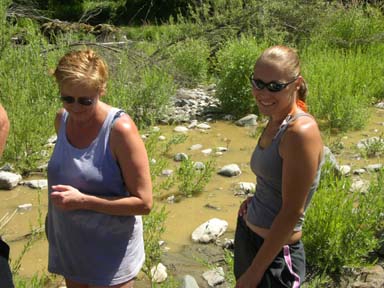 This particular project found us prospecting on the Highway 96-side of upper K-15A, otherwise known as the “Upper Mega-Hole.” Participants are supposed to bring their own basic prospecting tools, and especially a gold pan. They should wear clothes and foot ware that they don’t mind getting dirty and wet. A container or two of drinking water is always a good idea!
This particular project found us prospecting on the Highway 96-side of upper K-15A, otherwise known as the “Upper Mega-Hole.” Participants are supposed to bring their own basic prospecting tools, and especially a gold pan. They should wear clothes and foot ware that they don’t mind getting dirty and wet. A container or two of drinking water is always a good idea!
After everyone is gathered together out on the mining property, I take a moment to relay all or most of
the important information that we have collected from previous mining activity in the area. This is veryimportant; because knowing where others have found high-grade in the past will allow everyone a head start in being able to find more during the project.
Because gold is very heavy, it follows a common path down the waterway, and nearly always deposits along the bottom-edge of hard-packed layers of streambed. So if you know where others have already found high-grade in the area, you then know where to target your samples to find it again. This is what the basic sampling plan is all about! Since we do not have much time on a 2-day project, my personal mission is to direct as much energy as possible towards the areas where the gold is most likely to be found. The following video sequence captured some of our beginning moments as we began sampling for high-grade:
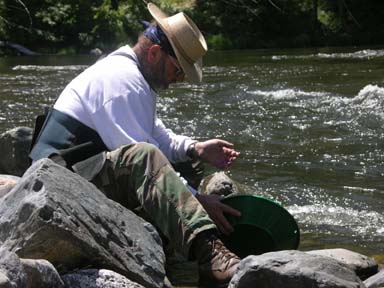 Once we are out there, the first thing everyone needs to do is demonstrate that they can operate a gold pan well. The remainder of Saturday will be devoted to locating a rich gold deposit with the use of gold pans. If your panning method is not capturing every speck of gold, you can easily miss the pay-streak even if you place your samples right down in the middle of a good deposit!
Once we are out there, the first thing everyone needs to do is demonstrate that they can operate a gold pan well. The remainder of Saturday will be devoted to locating a rich gold deposit with the use of gold pans. If your panning method is not capturing every speck of gold, you can easily miss the pay-streak even if you place your samples right down in the middle of a good deposit!
So after providing a panning demonstration to everyone who wanted to see it, I devoted the first hour or so just going around and critiquing everyone’s panning methods. Otto also helps with this. It usually comes down to just a few people who need some extra help. We focus on that until everyone in the program knows how to pan for gold without losing any in the process.
Since it is also important that we find high-grade before Saturday is finished out on the river, Craig and other experienced helpers usually get started in a serious sampling effort as soon as we get out on the river. This day was no different. Craig disappeared soon after we arrived on the river. So, as soon as everyone was panning alright, I went hunting for Craig to see if he had made any important gold strikes, yet. I found him towards the upper-end of K-15A. Craig was digging around the top layer of big rocks within the top layer of hard-pack.
Hard-packed streambed viewed from the surface.
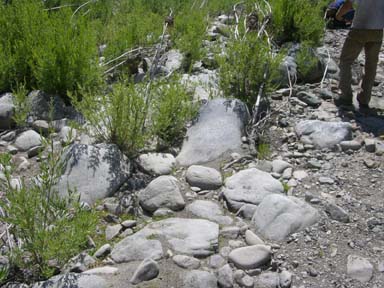 Fortunately, most of the high-grade gold deposits that we find in surface mining (out of the water) are located around the top layer of imbedded rocks. I say “fortunately” because it means you usually do not need to dig very deep to recover the gold. We believe most of the gold that we find in this top layer of hard-pack is gold that has washed down during large winter storms. This is why some prospectors call it “flood gold.” Imbedded rocks which protrude up through the surface layer form natural riffles. Gold being washed downstream during high-water becomes trapped between the rocks. Sampling is mainly a matter of freeing-up the top layer of embedded rocks, and panning the gravel-material that is between and just under them.
Fortunately, most of the high-grade gold deposits that we find in surface mining (out of the water) are located around the top layer of imbedded rocks. I say “fortunately” because it means you usually do not need to dig very deep to recover the gold. We believe most of the gold that we find in this top layer of hard-pack is gold that has washed down during large winter storms. This is why some prospectors call it “flood gold.” Imbedded rocks which protrude up through the surface layer form natural riffles. Gold being washed downstream during high-water becomes trapped between the rocks. Sampling is mainly a matter of freeing-up the top layer of embedded rocks, and panning the gravel-material that is between and just under them.
Craig was busy following the basic sample plan when I found him. He had placed himself in the same path, just a short distance upstream from where some earlier prospector had made a strike. Craig was gathering his sample along the bottom of the same layer of streambed that the other prospector was finding his gold. As Craig was digging in hard-pack, he already knew that no other prospector had been there since the flood layer was created by a major flood storm (probably the great flood of 1964)
In gold prospecting, the bigger the sample, the more accurate and dependable the result is going to be. Since we cannot make our gold pans bigger, we compensate by using a classification screen to eliminate larger-sized gravel and rocks. This allows us to double or triple the amount of gold-bearing-sized material that we actually process in the pan. Craig was screening his sample into his gold pan through an 8-mesh screen. The larger-sized material was being tossed to the side of where he was digging.
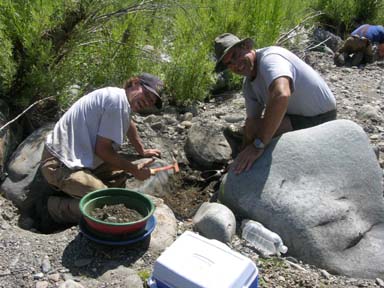 I showed up just in time to watch Craig work his sample down in the gold pan. And sure enough, there was a good showing of gold in the pan; 3 or 4 nice middle-sized flakes. Craig told me that the previous several pans were about the same. So Craig had already made a strike for this weekend project, just in case we were not able to find something better during the next few hours. This was good; my worries were pretty-much over for this project! Craig is my personal insurance plan that we will always recover some amount of gold on these projects!
I showed up just in time to watch Craig work his sample down in the gold pan. And sure enough, there was a good showing of gold in the pan; 3 or 4 nice middle-sized flakes. Craig told me that the previous several pans were about the same. So Craig had already made a strike for this weekend project, just in case we were not able to find something better during the next few hours. This was good; my worries were pretty-much over for this project! Craig is my personal insurance plan that we will always recover some amount of gold on these projects!
Having been managing these prospecting events for more than 20 years, my worries come down to: (1) don’t hurt anyone, and (2) make sure everyone leaves knowing how to operate a gold pan, and (3) send everyone home with as much gold as possible!
Wandering back down to where most of the others were actively sampling, several participants already had some pretty encouraging results of their own to show me. This is always the most rewarding part of the weekend for me. My job out there is to look at and compare the results of all the sampling. Someone is always finding something that looks encouraging. So, I ask others who have not been finding very much to help expand the sampling effort where we are finding more gold. Within an hour or so, we usually have everyone out there doing pan-samples in several different strikes. There can be a lot of excitement to go along with this. This is especially true with people who have never found their own gold before!
Here is a video sequence that captured how we were all working together to establish some high-grade gold:
One of the most valuable things we do during these weekend projects is show all of the participants exactly what hard-packed streamed is. “Hard-pack” is streambed that is formed by a major flood storm after pay-streaks are already formed. There is a world of difference between loose material or tailings from earlier mining activity, and naturally-formed streambed material (hard-pack). It is vital to know the difference, because almost all of the high-grade gold you will find along New 49’er mining properties will be located at the bottom-edge of one or more layers of hard-packed streambed. Knowing what to look for allows you to target your sampling activity at the right areas.
Another very important thing we do in these weekend projects is demonstrate how to place a relative value upon the amount of gold that is being found in a pan-sample. It is not unusual for a person to walk up with a great sample result, and say, “I didn’t get very much!” And it’s true that there is not very much gold in the pan. But that small amount of gold is only from about a single shovel of streambed material. That is a very small volume! Getting 4 or 5 nice little flakes of gold in a single pan can relate to a half-ounce or more of gold on Sunday when we have a dozen people shoveling the very same material into a high-banker!
A small showing of gold in a single pan-sample can add up to a lot of gold once you start processing more volume!
So, one of our goals during these projects is to help all of the participants gain the ability to relate how the gold found in pan-samples (on Saturday) will add up in a high-banker that will process more volume of the same material (on Sunday). While I am evaluating pan-sample results on Saturday afternoon, I make it a point to show around the sample results coming from the areas that we will work as a team on Sunday. I also try and get everyone to do some personal panning in those very same areas. This goes a long way to help beginners form a personal judgment about what is a good sample result when panning.
But on this particular day, most of the participants were totally absorbed in all the gold they were finding. Everyone gets to keep for themselves all the gold they find on Saturday afternoon. There was a lot of excitement going on; some people were yelling out their enthusiasm, having found their first-ever gold!
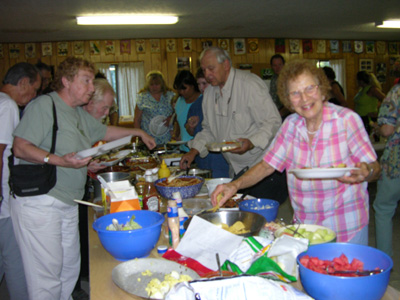 We do a weekly potluck gathering at the Happy Camp Lions hall nearly every Saturday evening during the season. The gathering starts at 6:30 pm, and we start dinner at around 7 pm. Then we do a short meeting and have a prize drawing. We have a lot of fun, and it gives members a chance for a weekly get-together.
We do a weekly potluck gathering at the Happy Camp Lions hall nearly every Saturday evening during the season. The gathering starts at 6:30 pm, and we start dinner at around 7 pm. Then we do a short meeting and have a prize drawing. We have a lot of fun, and it gives members a chance for a weekly get-together.
Some members look to the Saturday evening potluck as the highlight of their week!
To give everyone some time to clean up and pull something together to contribute to the evening meal, we wrapped up the sampling program out on the river at around 4:30 pm. Some participants were having too much fun out there to quit when we did. Still, I did notice that they made it to the potluck in time for dinner! We filled the Lions hall that evening, as we usually do.
Sunday morning found our energetic group packing several motorized high-bankers over to where we had made our strikes the day before. A high-banker is basically a sluicing device which can be set up near to where you want to dig. This way, your pay-dirt can either be shoveled or dredged directly into the recovery system, rather than packed some distance across land. A motorized pump provides water to the system through a flexible pressure hose.
With all that help, it did not take us very long to get things set up. We split the group into three different teams, each to operate their own high-banker. It wasn’t long before team leaders on each crew organized the activity. Some people were tossing the top loose rocks into piles. Others were using picks and pry bars to loosen-up the top layer of hard-pack. Others were filling 5-gallon buckets about half-full and packing the pay-dirt just a short distance to the high-bankers. Others were pouring a steady feed of material into the high-bankers. There was a whole lot of productive activity going on! Check out the following video sequence:
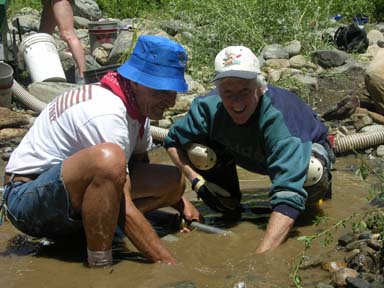 Once I was sure the high-bankers were operating with the proper water flow, and that they were being fed with pay-dirt at a good speed (not too fast, not too slow), my focus turned to the tailings water coming off the high-bankers. Dirty water is not allowed to flow back into the river. This is something that always determines where we set up the high-bankers in the first place! In this case, we had found a location where natural contours up on the gravel bar had already created a place that would trap the dirty water. That water was seeping into the gravel bar about as fast as we were pumping it up there. So we were not going to have any worries about washing dirty water back into the river.
Once I was sure the high-bankers were operating with the proper water flow, and that they were being fed with pay-dirt at a good speed (not too fast, not too slow), my focus turned to the tailings water coming off the high-bankers. Dirty water is not allowed to flow back into the river. This is something that always determines where we set up the high-bankers in the first place! In this case, we had found a location where natural contours up on the gravel bar had already created a place that would trap the dirty water. That water was seeping into the gravel bar about as fast as we were pumping it up there. So we were not going to have any worries about washing dirty water back into the river.
The other main job I have is to keep an eye on what participants are shoveling into the 5-gallon buckets that will be fed into the high-bankers. We only want high-grade material in those buckets! Once in a while, we get someone trying to help things along by shoveling sand or low-grade material into the buckets. That is counter-productive, because those low-grade buckets will ultimately be processed instead of other buckets that would contain high-grade material (more gold). Why do people do this? It’s usually because the loose material is easier to dig, and everyone wants to feel like they are helping.
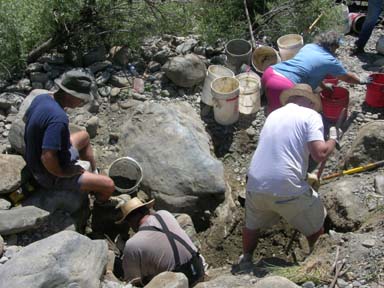 You learn early in gold mining that you can work all day and not recover very much gold if you are shoveling the wrong kind of material! But this particular group had been listening when I talked to them about this, and they were focused upon filling buckets with material from the layer of streambed that we had identified as being the pay-dirt.
You learn early in gold mining that you can work all day and not recover very much gold if you are shoveling the wrong kind of material! But this particular group had been listening when I talked to them about this, and they were focused upon filling buckets with material from the layer of streambed that we had identified as being the pay-dirt.
After a few hours of good hard work, we shut everything down for lunch and took a look in our recovery systems. There was lots of gold to be seen there. Some people were hooping and hollering, which is music to my ears. Enthusiasm is a good thing!
We don’t normally clean-up the recovery systems at lunch. This is because the process generally is time-consuming and would likely subtract from the amount of digging we can accomplish after lunch. After seeing all that gold, everyone ate just a little faster than normal so they could get back to work! This is pretty normal. Several participants were already filling buckets even before I finished my peanut butter and jelly sandwich. Gold fever! Everyone was pretty excited!
We processed more pay-dirt for another hour and a half after lunch. I closely watched how things were going. It gets pretty hot out there on Sunday afternoon. When people start slowing down, I know its time to begin shutting things down for the day.
Of course, the first part of shutting things down involves removing all of the gold concentrates from each recovery system. This was the part everybody had worked so hard for all day! The following video sequence captured some of those magic moments as we all got our first good look at the gold that we had recovered:
While one part of the crew cleaned the concentrates from the recovery systems, everyone else pitched in by back-filling our excavations with the rocks that we had been carefully placing in piles all day. By the time we left the area, you could not tell we had ever even been digging or prospecting there. 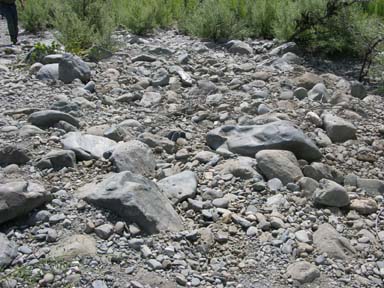 This is the right way to leave a prospecting excavation when you are finished with it!
This is the right way to leave a prospecting excavation when you are finished with it!
This is what an area should look like after you have finished prospecting there!
Note: I returned there a few weeks later with the top minerals officer for the Klamath National Forest, and he was not able to point out any of the places where we had been mining!
We timed things so that we were back at headquarters in Happy Camp with our final concentrates at around 2:30 on Sunday afternoon. What do I mean by “concentrates?” Like most other gold recovery systems, high-bankers do not just recover the gold. They recover a concentrate of all the heavy materials which have been shoveled into them. Concentrates normally consist of some (iron) black sands, along with the gold that has been recovered.
Back at our headquarters in Happy Camp, our mission for Sunday afternoon was to separate all of our gold from the other concentrated material. We have a special garage area in the back of our building where this “final clean-up“ process is accomplished. As this is something that every prospector needs to know how to do, we always invite all of the participants to either watch or help with the process. This enthusiastic group was all too ready to help!
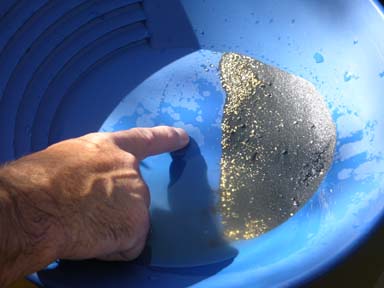 We use a special device for final gold separation which is called the “Gold Extractor.” This is basically a finely-tuned, narrow sluice that uses very low-profile riffles. In 30 years as a serious prospector, I have never seen a more effective portable tool for reducing concentrates down to a very small volume (about the amount of a rounded tablespoon) – with zero loss of gold during the process. The whole idea is to reduce the amount of concentrates down to a small enough volume that can be dried for final separation.
We use a special device for final gold separation which is called the “Gold Extractor.” This is basically a finely-tuned, narrow sluice that uses very low-profile riffles. In 30 years as a serious prospector, I have never seen a more effective portable tool for reducing concentrates down to a very small volume (about the amount of a rounded tablespoon) – with zero loss of gold during the process. The whole idea is to reduce the amount of concentrates down to a small enough volume that can be dried for final separation.
Our most experienced panners went through the tailings from the Gold Extractor and were not able to locate a single speck of lost gold. Everyone was happy about that!
After drying our final concentrates, we passed them over a set of final clean-up classification screens to separate the material into several different sizes. The different sizes of concentrate were then placed on separate clean sheets of paper so we could carefully complete the final separation – mainly by gently blowing away the iron sands. This is usually not very hard to do, because the iron is about 3 times lighter than the gold.
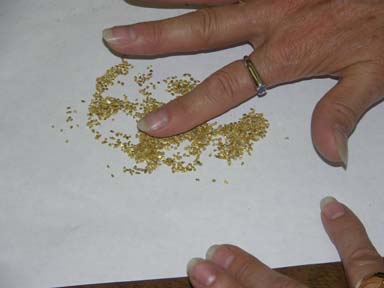 By around 5 pm, we had all the gold cleaned up and on the weight scale. It weighted out at about 13.3 pennyweights. That’s almost 3/4 of an ounce. This was pretty good for about 3 ½ hours of hard work! It was especially good, being that none of us even knew that particular gold deposit existed on Saturday morning!
By around 5 pm, we had all the gold cleaned up and on the weight scale. It weighted out at about 13.3 pennyweights. That’s almost 3/4 of an ounce. This was pretty good for about 3 ½ hours of hard work! It was especially good, being that none of us even knew that particular gold deposit existed on Saturday morning!
After taking a few moments to pat ourselves on the backs for a job well done, I carefully weighed the gold into equal shares for everyone who participated. I like to place the gold shares in small glass sample viles. But some people prefer to keep their shares in small zip lock baggies. Here is a video sequence that captured part of the final clean-up:
The project was over by 6 pm on Sunday evening. Some participants went away with the first gold they had ever found. Most went away with big smiles on their faces. Everyone went away with a full understanding of how successful gold prospecting is accomplished, from pan-sampling, to production-mining on a small scale, to final clean-up and gold separation. That was going help each of them to become more successful in their own prospecting activities.



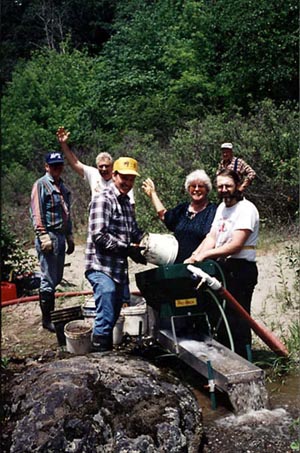 We expected an information-packed, tiring weekend. Even as we planned our trip and packed the car, however, my wife Robin and I never imagined how enjoyable it would be to attend a New 49’ers mining project. Each summer, Dave McCracken of the New 49’ers holds an assortment of
We expected an information-packed, tiring weekend. Even as we planned our trip and packed the car, however, my wife Robin and I never imagined how enjoyable it would be to attend a New 49’ers mining project. Each summer, Dave McCracken of the New 49’ers holds an assortment of 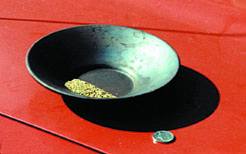
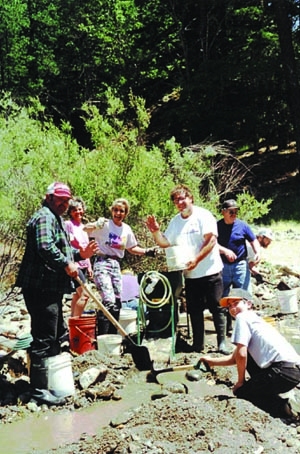 Saturday evening is New 49’ers
Saturday evening is New 49’ers 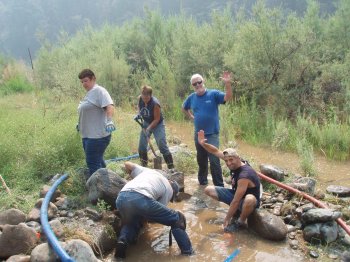
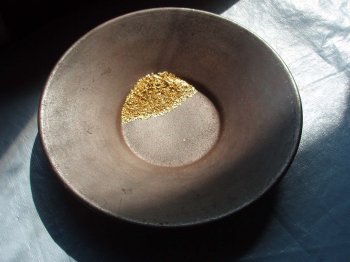
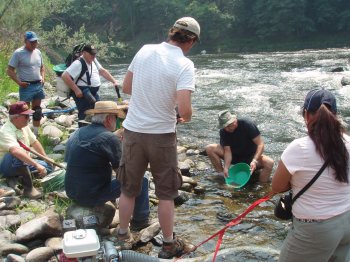 There is another very important thing that Dave demonstrates during these outings. He keeps saying, “Proper sampling is a very exact process.” Since most high-grade gold deposits are located either on top or at the bottom of a compacted flood layer, it is important to be very careful to first clear any sand, loose gravel or other low-grade material from the surface that you want to test. Then, you pass the exact material that you want to test through the proper size of
There is another very important thing that Dave demonstrates during these outings. He keeps saying, “Proper sampling is a very exact process.” Since most high-grade gold deposits are located either on top or at the bottom of a compacted flood layer, it is important to be very careful to first clear any sand, loose gravel or other low-grade material from the surface that you want to test. Then, you pass the exact material that you want to test through the proper size of 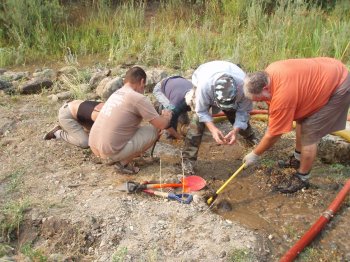 The truth is that it takes quite a lot of effort if you just pick up the suction nozzle outside of a waterway and start sucking material with it. This is because you have to lift the full weight of the nozzle, pressure hose and suction hose ” which are all filled with water. That”s a lot of weight to manipulate around if you want to operate the suction nozzle as we would normally do when dredging under the water.
The truth is that it takes quite a lot of effort if you just pick up the suction nozzle outside of a waterway and start sucking material with it. This is because you have to lift the full weight of the nozzle, pressure hose and suction hose ” which are all filled with water. That”s a lot of weight to manipulate around if you want to operate the suction nozzle as we would normally do when dredging under the water.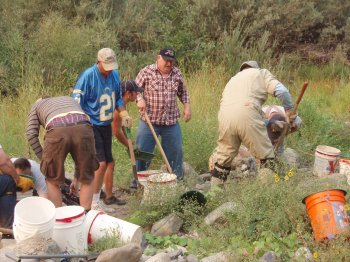
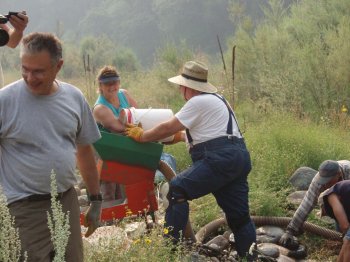
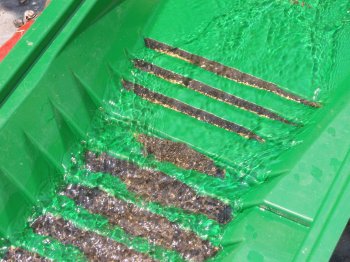 At lunch time, even after over three hours of mud, sweat, lots of water and moving rocks, I could not get anyone to break for lunch. No really; they did not want to get out of the water! Finally, they decided to break in shifts so they could keep the nozzles working. Stops only occurred when the engines ran out of gas, and once when we lost a hose clamp. What a dedicated group of people (or was it just
At lunch time, even after over three hours of mud, sweat, lots of water and moving rocks, I could not get anyone to break for lunch. No really; they did not want to get out of the water! Finally, they decided to break in shifts so they could keep the nozzles working. Stops only occurred when the engines ran out of gas, and once when we lost a hose clamp. What a dedicated group of people (or was it just 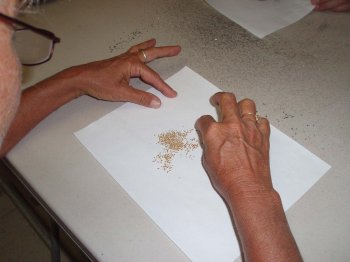 One of the most important things I have learned from these projects is that successful gold mining is not just about hard work. To recover a lot of gold, you have to work hard at locating and processing
One of the most important things I have learned from these projects is that successful gold mining is not just about hard work. To recover a lot of gold, you have to work hard at locating and processing 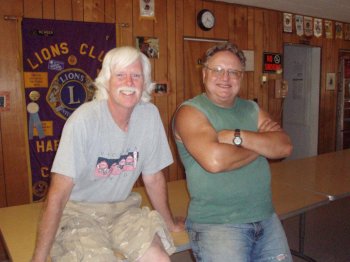 About 30 minutes later, we found ourselves back at the Lions Club in Happy Camp where we were able to complete the final clean-up using a
About 30 minutes later, we found ourselves back at the Lions Club in Happy Camp where we were able to complete the final clean-up using a 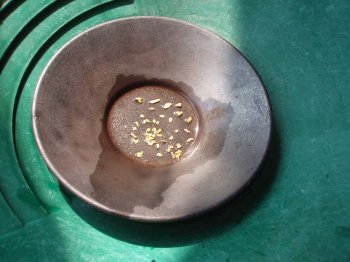 This was my forth outing of this season, and I am so glad that I was able to be a part of it. I have met the greatest people, had a wonderful time, and I am a little sad each time an outing participant says goodbye for awhile. I can only tell you from my experience that if you find yourself with time, please come on out and visit with us, join us on an outing, enjoy the beautiful area around us and take home some fantastic memories. You won”t be sorry you came, and you will leave with more than you came with, in more ways than one. Please
This was my forth outing of this season, and I am so glad that I was able to be a part of it. I have met the greatest people, had a wonderful time, and I am a little sad each time an outing participant says goodbye for awhile. I can only tell you from my experience that if you find yourself with time, please come on out and visit with us, join us on an outing, enjoy the beautiful area around us and take home some fantastic memories. You won”t be sorry you came, and you will leave with more than you came with, in more ways than one. Please 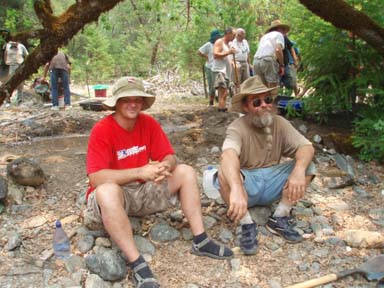
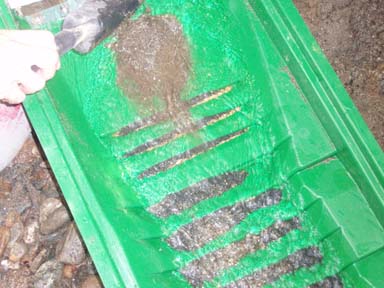
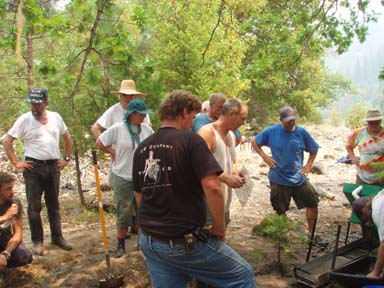 Once we arrived there, Dave and his experienced helpers divided everyone into four separate groups, each with their own team leader setting the pace. Then we all launched into a carefully-coordinated sampling program.
Once we arrived there, Dave and his experienced helpers divided everyone into four separate groups, each with their own team leader setting the pace. Then we all launched into a carefully-coordinated sampling program.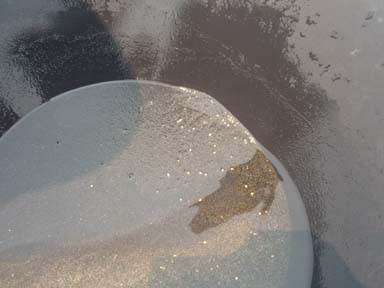 By
By 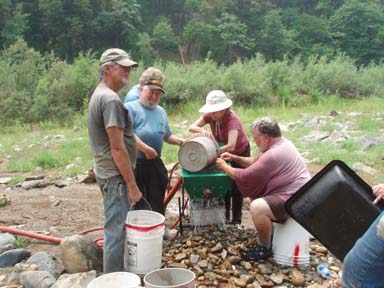 Several other areas were being sampled by the other team leaders and their crews also turned up good results. By late afternoon on Saturday, we were already setting up the
Several other areas were being sampled by the other team leaders and their crews also turned up good results. By late afternoon on Saturday, we were already setting up the 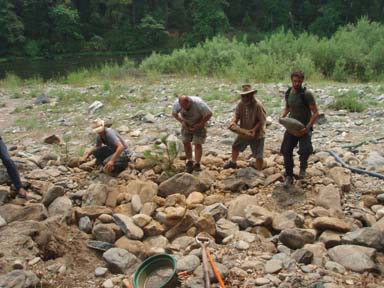 Sunday morning, I arrived out on K-15A at 8:15 am,
Sunday morning, I arrived out on K-15A at 8:15 am,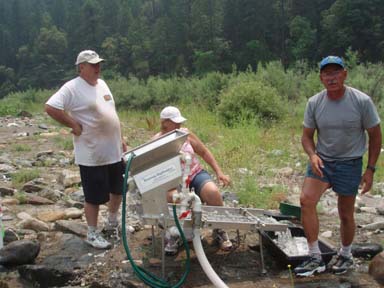
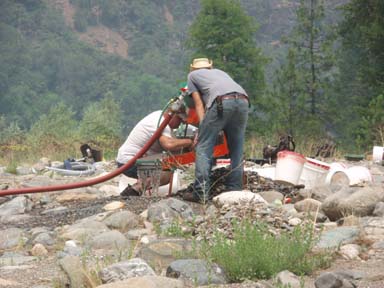
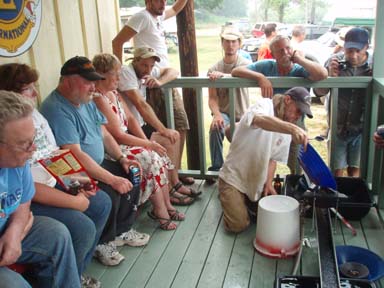 Once all the holes from the digs were filled in and the debris picked up and packed out, we headed back to Happy Camp where we would complete the final clean up and split. A “
Once all the holes from the digs were filled in and the debris picked up and packed out, we headed back to Happy Camp where we would complete the final clean up and split. A “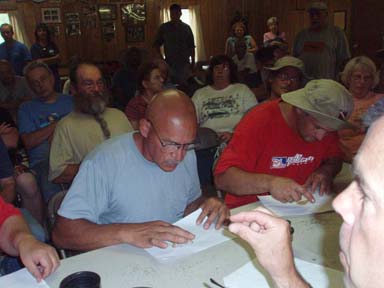
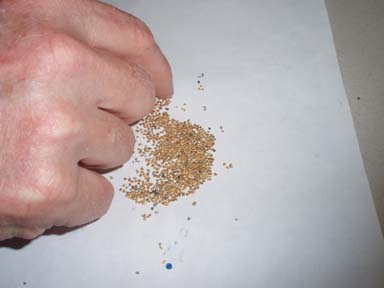
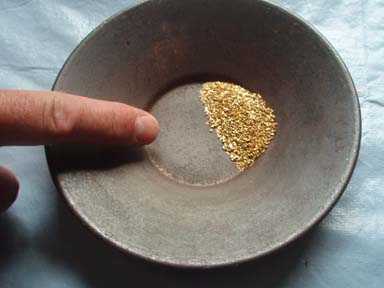
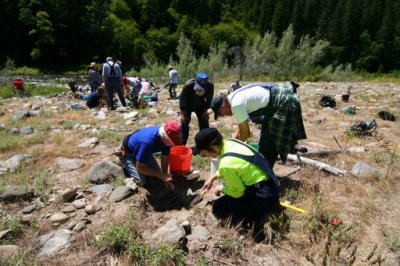
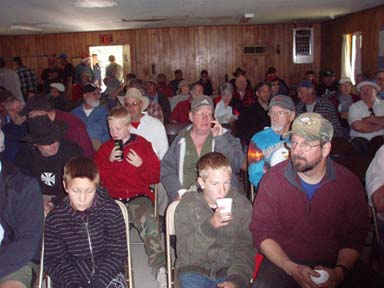 California Gold Rush.” The other two journalists, Justin and John, were from New York. They were representing Fortune Small Business Magazine, speaking with those in attendance regarding their feelings on gold prospecting, why they were here, and what they enjoyed about the whole
California Gold Rush.” The other two journalists, Justin and John, were from New York. They were representing Fortune Small Business Magazine, speaking with those in attendance regarding their feelings on gold prospecting, why they were here, and what they enjoyed about the whole 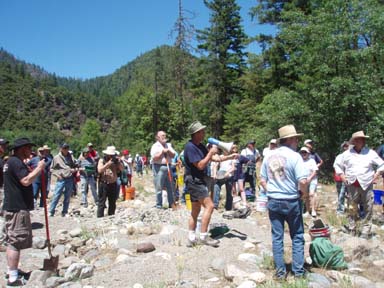 Armed with all the useful information and necessary gear, we all headed off after lunch to
Armed with all the useful information and necessary gear, we all headed off after lunch to 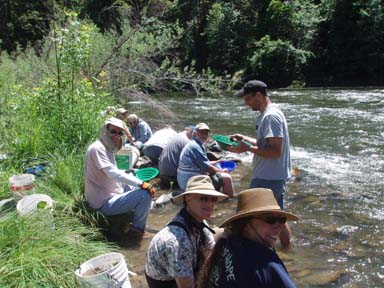
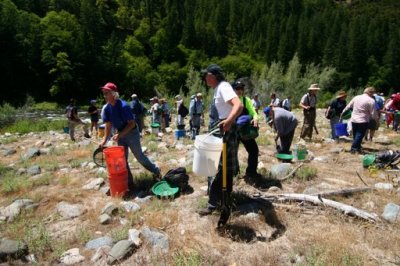
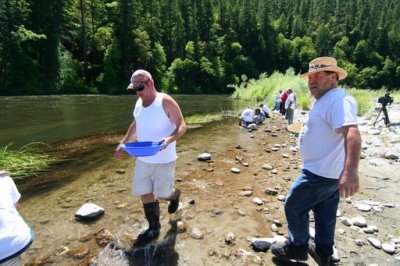
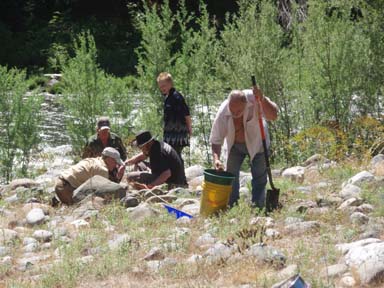 During a short lunch break, everyone had their first glimpse of what all their hard work was for. You could almost touch the excitement when Dave swished around a sample from the high-bankers in a gold pan for all to see. Anyone who has ever experienced that moment knows exactly what I am talking about; gold fever! We were getting a lot of
During a short lunch break, everyone had their first glimpse of what all their hard work was for. You could almost touch the excitement when Dave swished around a sample from the high-bankers in a gold pan for all to see. Anyone who has ever experienced that moment knows exactly what I am talking about; gold fever! We were getting a lot of 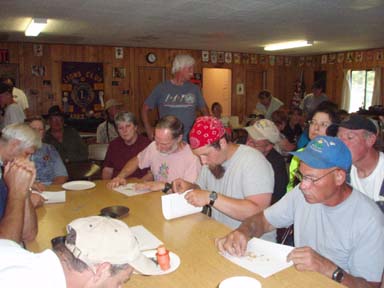
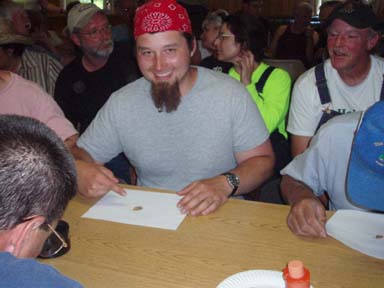
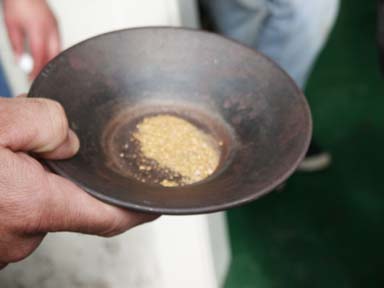
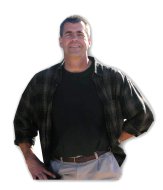
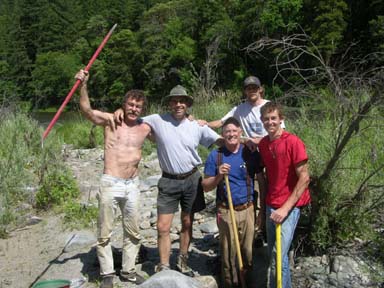
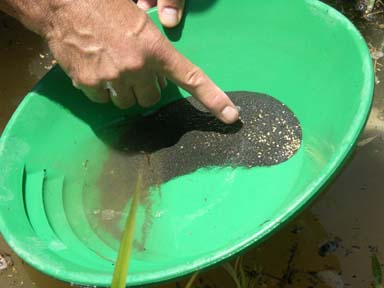
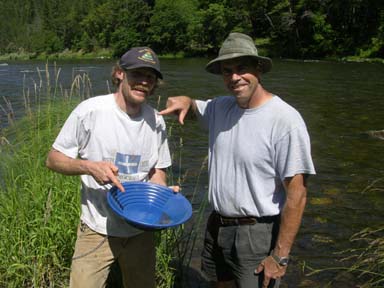
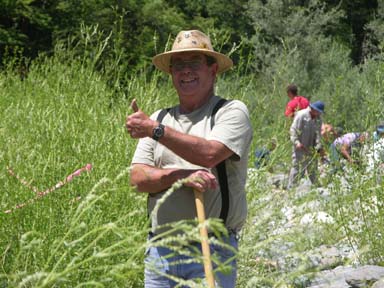
 This particular project found us prospecting on the Highway 96-side of upper
This particular project found us prospecting on the Highway 96-side of upper 

 I showed up just in time to watch Craig work his sample down in the gold pan. And sure enough, there was a
I showed up just in time to watch Craig work his sample down in the gold pan. And sure enough, there was a 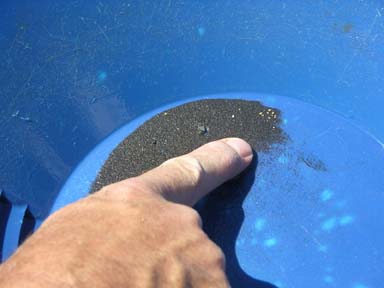
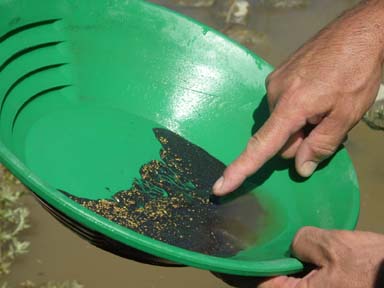
 We do a weekly
We do a weekly  Once I was sure the high-bankers were operating with the
Once I was sure the high-bankers were operating with the  You learn early in gold mining that you can work all day and not recover very much gold if you are shoveling the wrong kind of material! But this particular group had been listening when I talked to them about this, and they were
You learn early in gold mining that you can work all day and not recover very much gold if you are shoveling the wrong kind of material! But this particular group had been listening when I talked to them about this, and they were 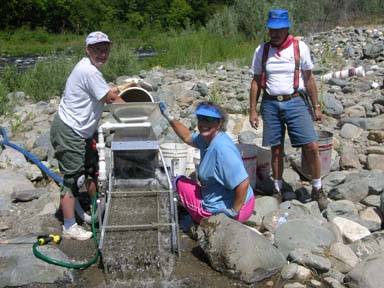
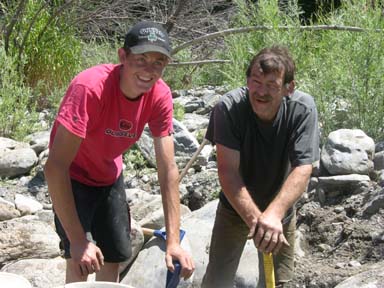



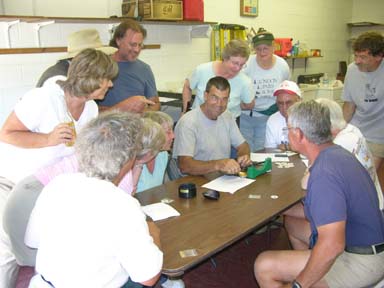
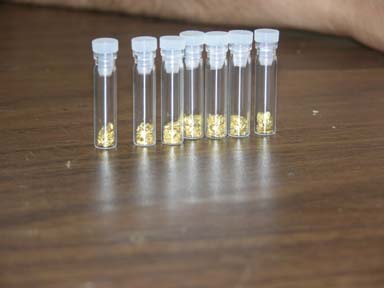

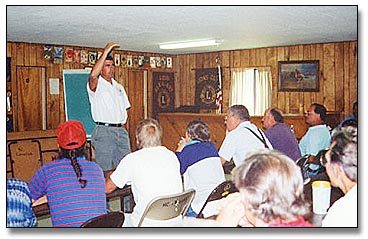 It felt like being back in school again, with the large chalkboard looming in front of us. Dave McCracken, founder of The New 49’ers and known worldwide for his abilities in gold mining, started off the day by asking all participants to introduce themselves and talk a little about where they had come from.
It felt like being back in school again, with the large chalkboard looming in front of us. Dave McCracken, founder of The New 49’ers and known worldwide for his abilities in gold mining, started off the day by asking all participants to introduce themselves and talk a little about where they had come from.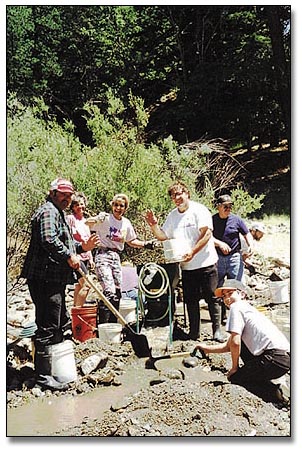 people to really get down to what was on their minds. Some had prior experiences and were looking for answers on how to improve their skills.
people to really get down to what was on their minds. Some had prior experiences and were looking for answers on how to improve their skills.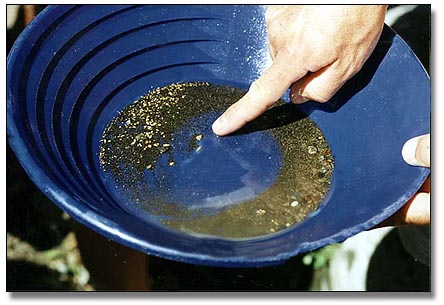 At around 4:30 pm, we knocked off for the day to give those of us who wanted to go, a chance to get ready for the
At around 4:30 pm, we knocked off for the day to give those of us who wanted to go, a chance to get ready for the 
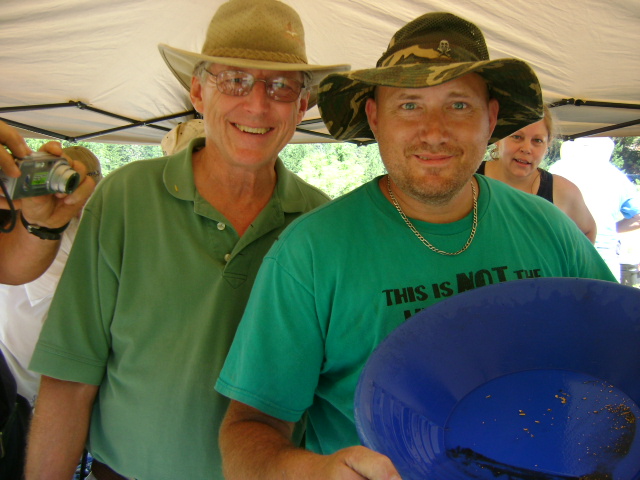
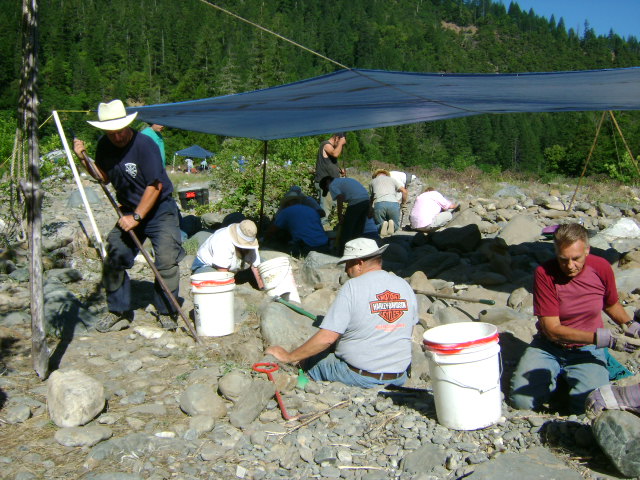
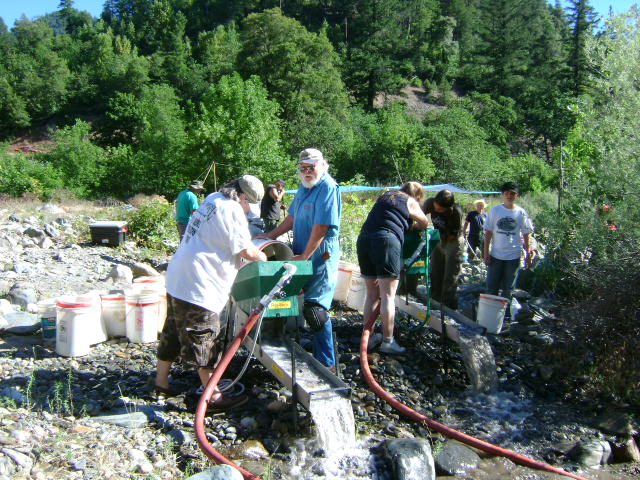
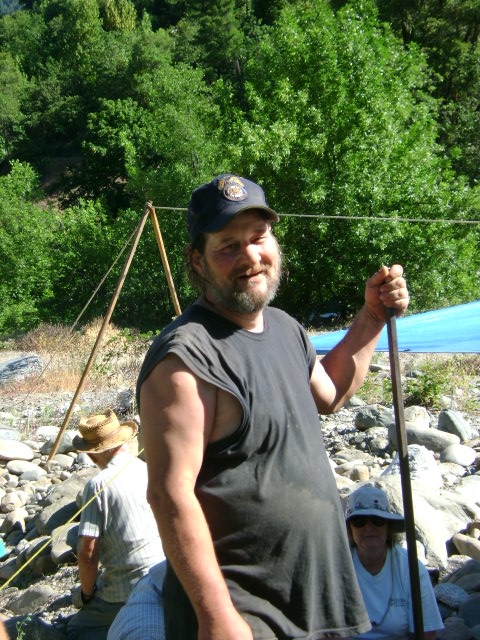 Over the years, I have discovered that every single group is different. It is something about how the combined social chemistry comes together. This all gels during introductions on the first morning. Some groups are more enthusiastic than others.
Over the years, I have discovered that every single group is different. It is something about how the combined social chemistry comes together. This all gels during introductions on the first morning. Some groups are more enthusiastic than others. 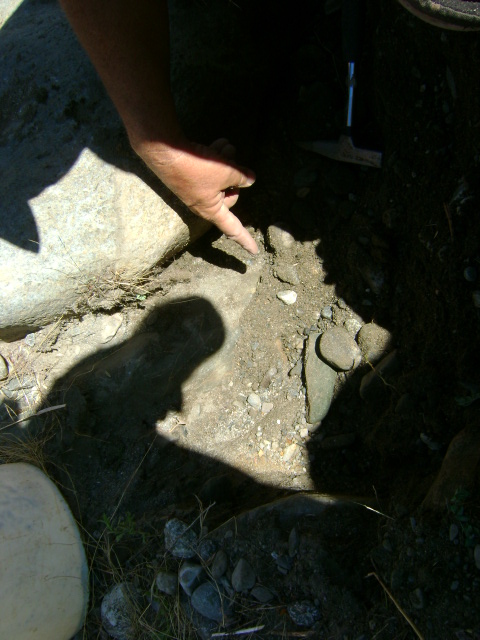 Another of the first things we do once out in the field, is to show everyone what hard-pack streambeds are, what the different layers look like, and exactly where we have been
Another of the first things we do once out in the field, is to show everyone what hard-pack streambeds are, what the different layers look like, and exactly where we have been 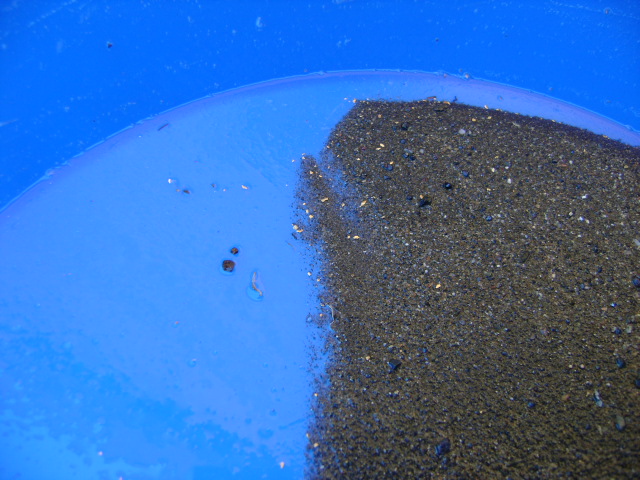 Since there are always beginners present, I also provide a
Since there are always beginners present, I also provide a 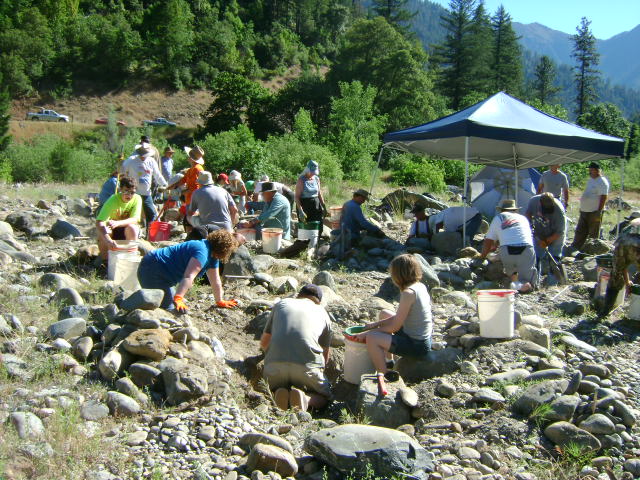
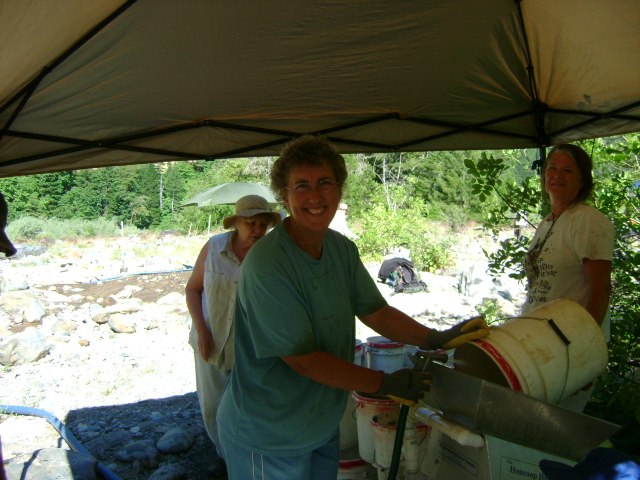
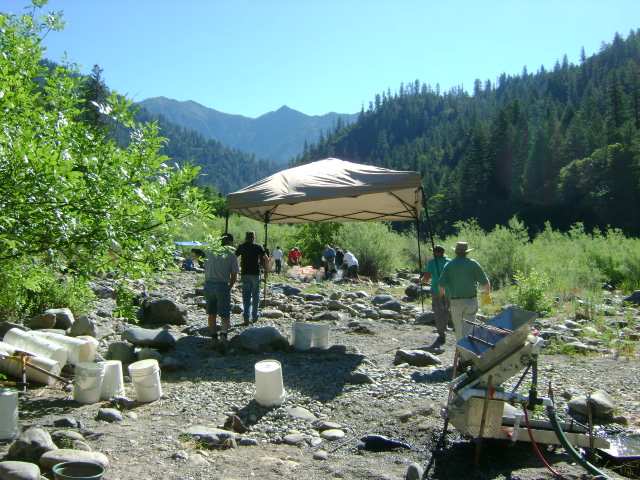 smoothly. Here are three video segments which captured some of the action:
smoothly. Here are three video segments which captured some of the action: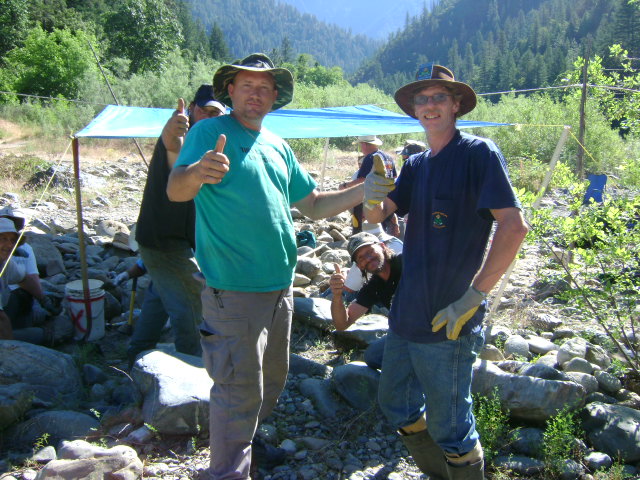
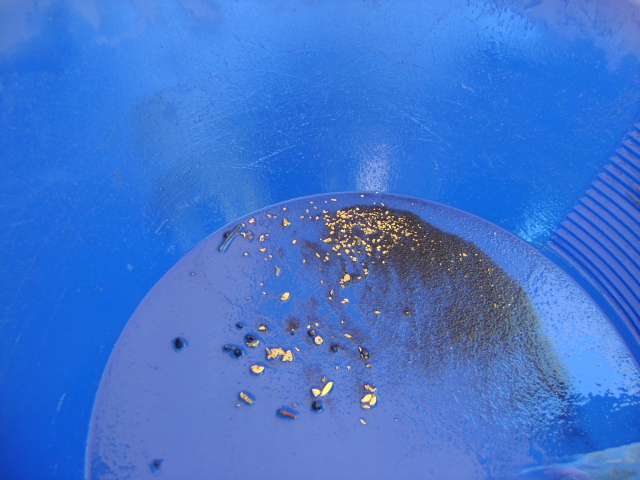
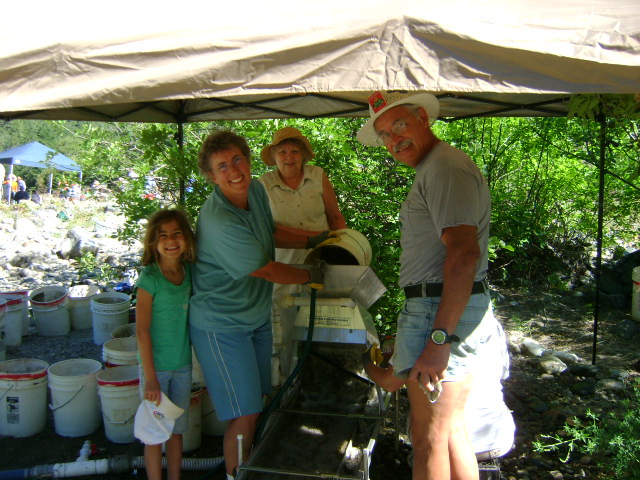
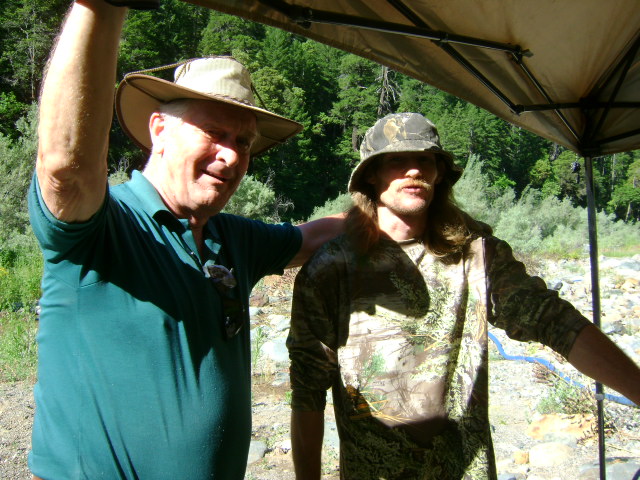
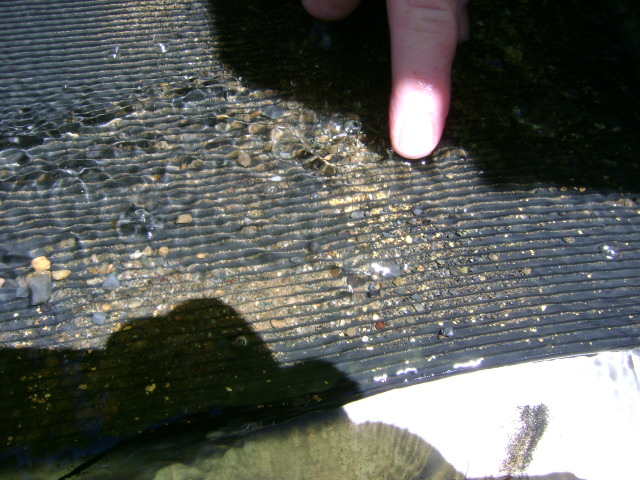
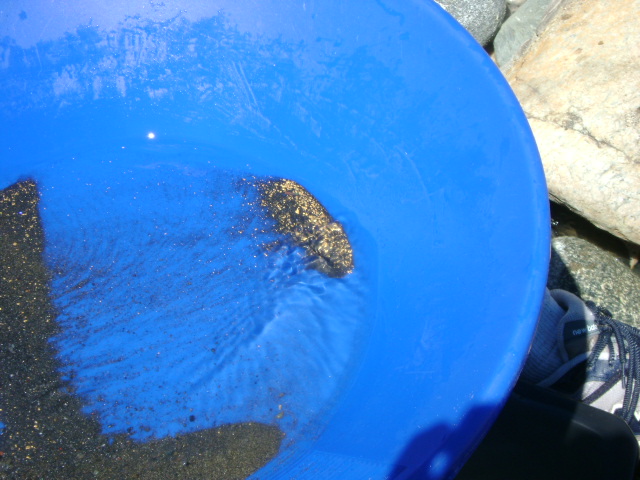
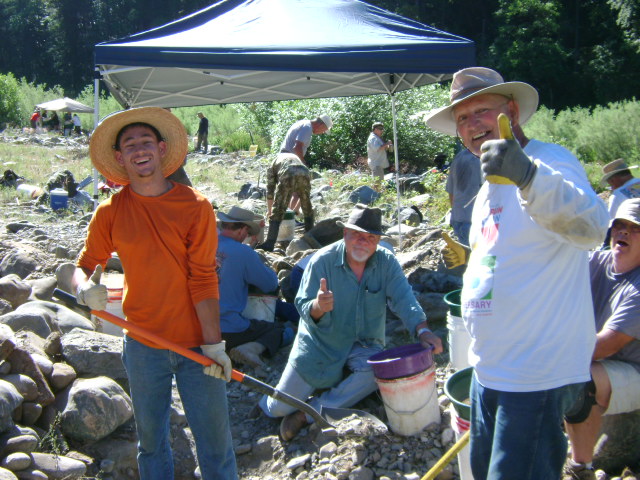
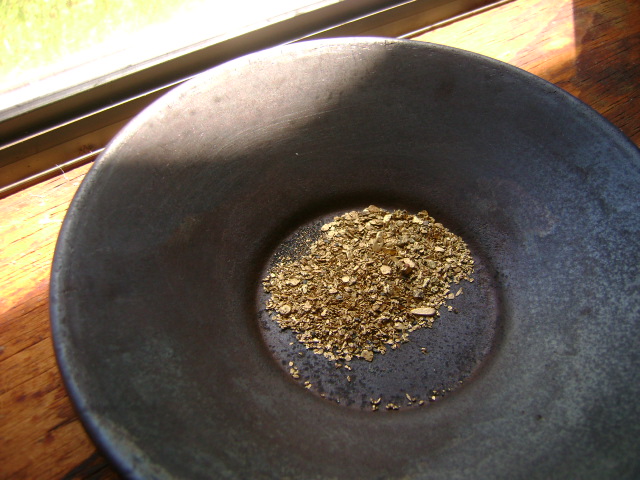
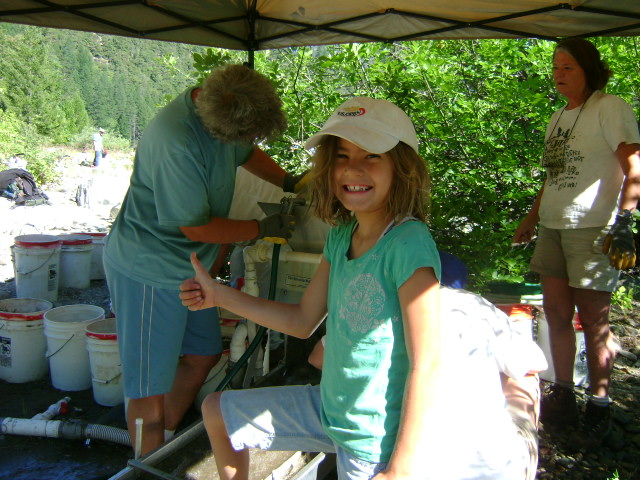


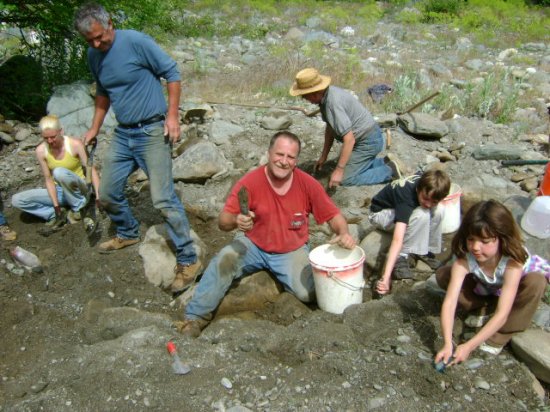
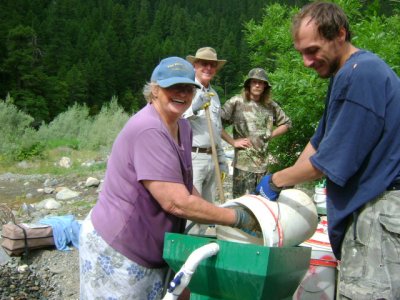
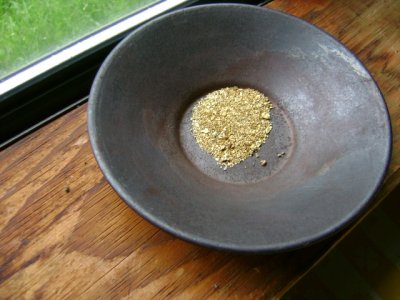
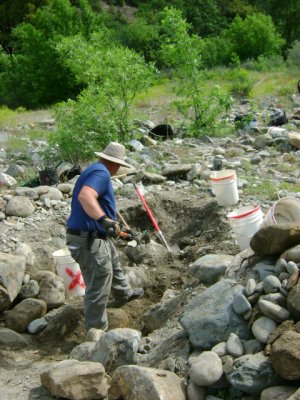 Then, even before we finished the first gold line, maybe two seasons ago, someone discovered an entirely new line of high-grade gold that ran the entire length of the bar perhaps 30 feet further inland from the first line of gold. That is the line of gold that we were mining all last season. As this second line had not been worked very much towards the upper-end of the bar, my plan has been to focus our high-banking projects up that way this summer. There is still
Then, even before we finished the first gold line, maybe two seasons ago, someone discovered an entirely new line of high-grade gold that ran the entire length of the bar perhaps 30 feet further inland from the first line of gold. That is the line of gold that we were mining all last season. As this second line had not been worked very much towards the upper-end of the bar, my plan has been to focus our high-banking projects up that way this summer. There is still 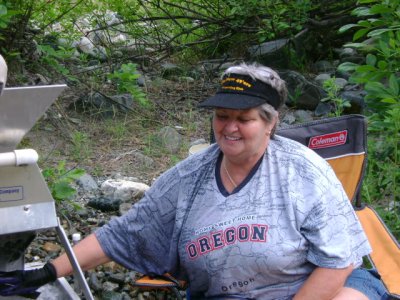
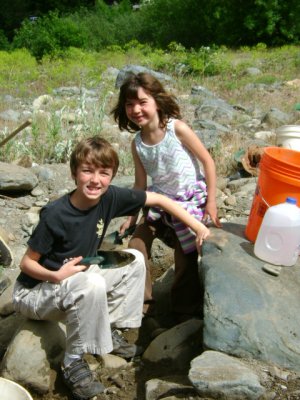
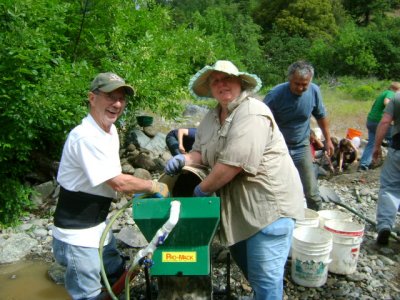
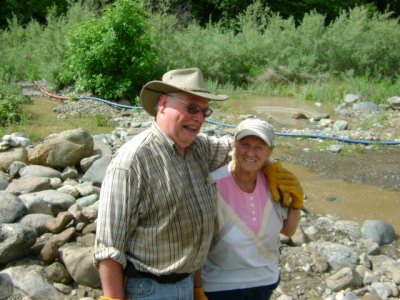
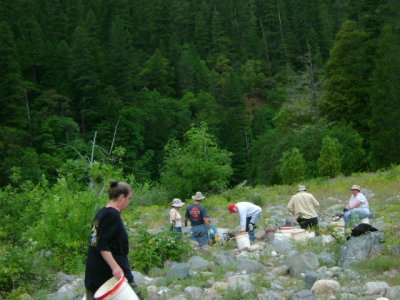
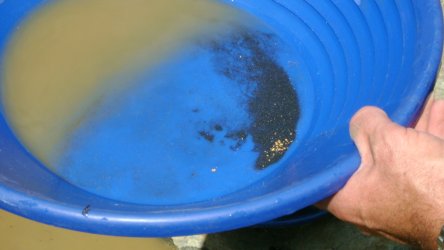
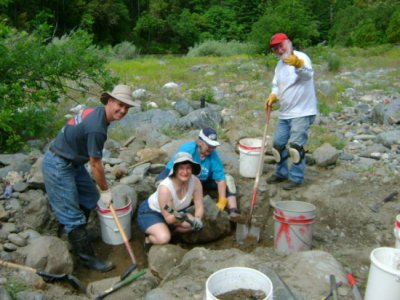
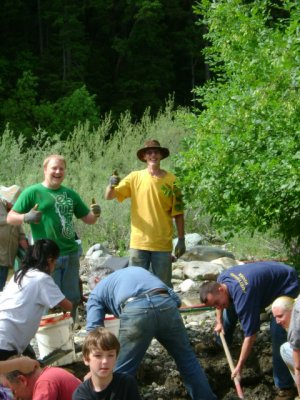 And that’s the way it was on this Saturday afternoon as soon as our participants began digging a little further inland. They started coming up with good pans right away. At first, I thought it was just an anomaly; perhaps a little gold located off the main line. Then, others started recovering the same kind of gold. The average pieces were larger than from the earlier line that we had established down closer to the river. Wow, this was a real bonus!
And that’s the way it was on this Saturday afternoon as soon as our participants began digging a little further inland. They started coming up with good pans right away. At first, I thought it was just an anomaly; perhaps a little gold located off the main line. Then, others started recovering the same kind of gold. The average pieces were larger than from the earlier line that we had established down closer to the river. Wow, this was a real bonus!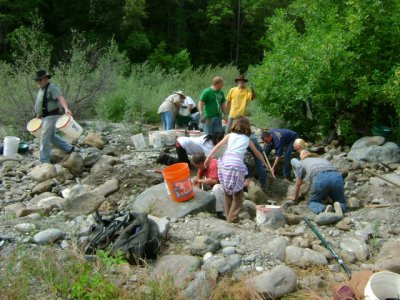
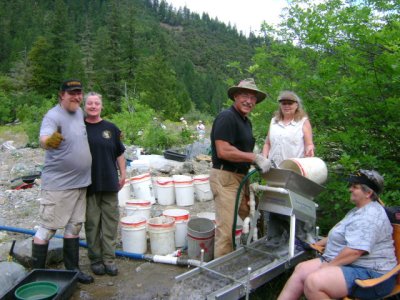
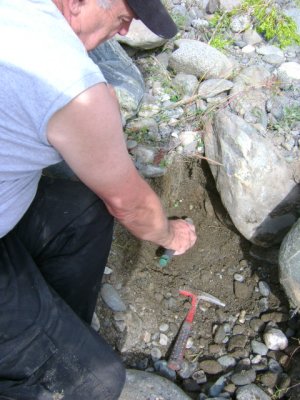 This new pay-streak is positioned along the bottom of a top layer of hard-packed streambed, which is sitting on top of a really hard layer of dark brown material. Sometimes, the lower layer looks like dirt. It is
This new pay-streak is positioned along the bottom of a top layer of hard-packed streambed, which is sitting on top of a really hard layer of dark brown material. Sometimes, the lower layer looks like dirt. It is 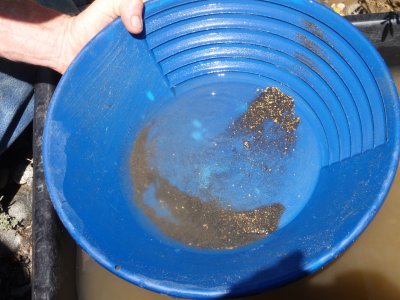 The depth of the pay layer also makes a difference in how much gold you need to see in your pan when sampling. The deeper that you have to dig, the richer the pay-dirt must be to make a mining program pay off to your satisfaction. Finding this whole new line of gold on K-15A was truly a stroke of luck. Here follows a video segment capturing my own explanation as all the action was happening:
The depth of the pay layer also makes a difference in how much gold you need to see in your pan when sampling. The deeper that you have to dig, the richer the pay-dirt must be to make a mining program pay off to your satisfaction. Finding this whole new line of gold on K-15A was truly a stroke of luck. Here follows a video segment capturing my own explanation as all the action was happening: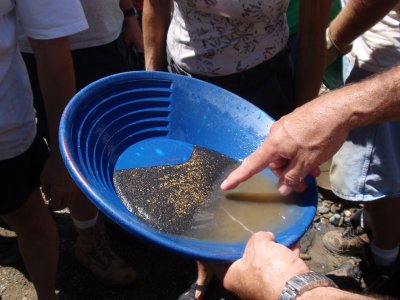
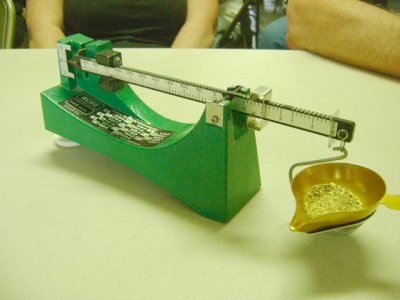 In all, we recovered 16.4 pennyweights of gold. That is more than ¾ of an ounce, or $1,000 at the current gold price. There were 14 nuggets. This is pretty good considering that we operated three high-bankers for several hours. Here follows Rich Krimm’s introduction to the final clean-up and gold split. We had a lot of fun. Check it out:
In all, we recovered 16.4 pennyweights of gold. That is more than ¾ of an ounce, or $1,000 at the current gold price. There were 14 nuggets. This is pretty good considering that we operated three high-bankers for several hours. Here follows Rich Krimm’s introduction to the final clean-up and gold split. We had a lot of fun. Check it out:


